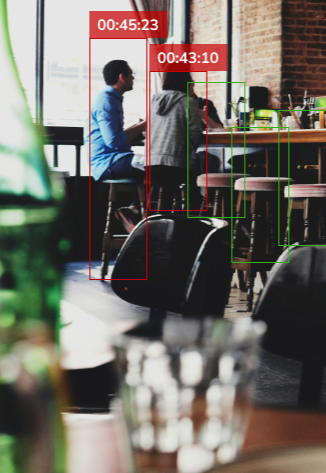The Occupancy Monitoring system leverages AI and video analytics to track table occupancy. It identifies which tables are occupied or vacant, along with tracking how long a table has been occupied. This helps hospitality businesses optimize seating, enhance customer service, reduce wait times, and improve overall operational efficiency.
Occupied and Empty Tables with Duration

Manually tracking table occupancy and availability can be inaccurate, leading to inefficient seating, longer customer wait times, and a suboptimal dining experience.
During busy periods, staff may struggle to monitor when tables become free, increasing wait times and customer dissatisfaction.
Poor visibility into table occupancy may lead to underutilized seating areas, reducing the restaurant's ability to serve more guests, especially during peak hours.
Without accurate information about how long tables have been occupied, staff may overlook customers who have been seated for extended periods, negatively impacting service quality.

To address these challenges, we implemented an AI-powered Occupancy Monitoring system. This system uses cameras to track real-time occupancy data and analyze table usage patterns, enabling businesses to streamline operations and enhance customer satisfaction.
The system uses CCTV cameras to monitor which tables are occupied or empty, providing instant updates to restaurant staff on availability.
The system not only tracks whether a table is occupied but also how long it has been in use. This allows staff to prioritize service for tables that have been occupied for extended periods.
With a visual dashboard showing table status and duration, the system helps hosts and managers quickly assign guests to available tables, reducing wait times and improving seating efficiency.
Detailed reports on table occupancy and duration help management understand peak hours, optimize seating arrangements, and make data-driven decisions to maximize revenue.
Ensuring the cameras have clear views of all tables, particularly in large or complex dining areas, can be challenging.
Cameras need to handle various lighting conditions, such as dim lighting in certain sections, without losing accuracy in tracking occupancy.
In crowded restaurants or hotels, differentiating between guests moving around and those seated requires sophisticated AI models to avoid misidentification.
Monitoring busy waiting areas and ensuring tables are properly flagged as "occupied" only when guests are seated can be tricky.
Integrating the occupancy system with existing point of sale (POS) and reservation systems is essential to streamline operations but requires technical compatibility.
Processing real time data for multiple tables during peak times without lag or system crashes is a key technical requirement.
Frequent changes in table occupancy during busy hours make real time tracking crucial but technically demanding.
Detecting when a guest has vacated a table and cleaning or resetting the table promptly is necessary to maintain efficiency.
With real-time data on available tables, staff were able to reduce average customer wait times by 20%, significantly improving customer satisfaction, especially during peak hours.
The monitoring of table duration allowed staff to prioritize service for tables that had been occupied the longest, reducing complaints about slow service and enhancing the overall dining experience.
The automated system relieved staff from manually tracking tables, enabling them to focus on customer service. This streamlined operations and allowed managers to make data-driven decisions on seating optimization.
Occupancy data and reports helped management identify peak hours, adjust staffing levels accordingly, and make strategic changes to seating arrangements to accommodate more guests during busy periods.
The system helped identify underutilized seating areas, allowing for better table management and increasing overall table turnover by 15%, leading to higher revenue.
This website uses cookies to improve your experience. We'll assume you're ok with this, but you can back-out if you wish.